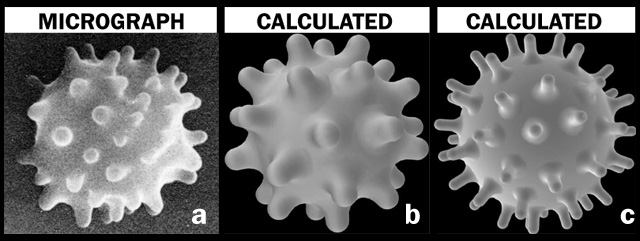| BIOMEMBRANES
Microtubes and nanotubes of a phospholipid bilayer membrane
Phoshpholipid vesicle with thin tubular protrusion (AVI movie. V Kralj-Iglič, comp. ad. M. Kač, O. Bregar in M. Malneršič)
The phospholipid vesicles appearing as composed of a mother sphere and a thin micro- or nano-tubular protrusion, are found to be a common phase in the spontaneous slow shape transformation that yields giant fluctuating phospholipid vesicles of different shapes, which has been observed for the first time /Coll. Surf. A, 181 (2001) 315-318/. We propose a theory describing the stable structure of a phospholipid bilayer in pure water involving a spherical mother vesicle with long thin micro- or nano-protrusion /J. Phys. A: Math. Gen. 35 (2002) 1533-1349/.
It is considered that the phospholipid molecules are in general anisotropic with respect to the axis normal to the membrane and can orient in the plane of the membrane if the curvature field is strongly anisotropic. Taking this into account, the membrane free energy is derived starting from a single-molecule energy and using methods of statistical mechanics. By linking the description on the miscoscopic level with the continuum theory of elasticity we recover the expression for the membrane bending energy and obtain an additional (deviatoric) contribution due to the orientational ordering of the phospholipid molecules.
It is shown that the deviatoric contribution may considerably decrease the phospholipid vesicle membrane free energy if the vesicle involves regions where the difference between the two principal curvatures is large (thin cylindrical protrusions and/or thin finite necks) and thereby yields a possible explanation for the stability of the long thin micro- and nano-tubular protrusions of the phospholipid bilayer vesicles. We report on the experiment exhibiting a stable shape of the spherical phospholipid vesicle with a long thin tubular protrusion in pure water.
Echinocyte shape
We have shown for the first time that stability of echinocyte shape is primarily determined by competition of the membrane bilayer bending energy and membrane skeleton energy.

Micrograph of echinocyte shape (adopted from Bessis, 1973) (a) and the calculated echinocyte shapes determined by minimization of membrane elastic energy (bending and shear) for two values of the relative area difference between the areas of the outer and inner membrane lipid layer (a) : 2.06 (b) and 3.2 (c) at the relative cell volume v=0.6 (adapted from Iglic et. al., Eur. Biophys. J., 27: 335-339 (1998), Iglic, J. Biomechanics, 30: 35-40 (1997) and Iglic. el. al., Bioelectrochemistry 62: 159-161 (2004).The quantities  a and v are normalized relative to the corresponding values for the spherical cell with the same membrane area. a and v are normalized relative to the corresponding values for the spherical cell with the same membrane area.
Small phospholipid vesicles may travel along the nanotube
We indicate that membrane nanotubes may have an important role in directed transport of membrane vesicles between different membrane-enclosed compartments in cells. We present experimental evidence that small blebs of phospholipid nanotube may travel along the nanotube and act as vehicles for transporting the enclosed solution. We have also observed similar small membrane blebs of a long membrane tube in red blood cells. In both cases the small vesicles seem to be a distended integral part of the membrane tube and not independent vesicles entrapped within the tube /Phys. Lett. A 310 (2003) 493-497/.
Organic nanotubes. Proteus 66/3 (2003) 106-111. |

